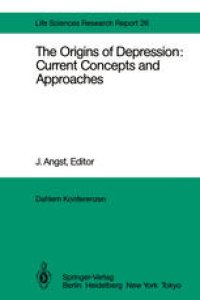
Ebook: The Origins of Depression: Current Concepts and Approaches: Report of the Dahlem Workshop on The Origins of Depression: Current Concepts and Approaches Berlin 1982, Oct.31 – Nov. 5
Author: J. Angst (auth.) J. Angst (eds.)
- Tags: Psychiatry
- Series: Dahlem Workshop Reports Life Sciences Research Report 26
- Year: 1983
- Publisher: Springer-Verlag Berlin Heidelberg
- Edition: 1
- Language: English
- pdf
3 and a fraction mayor may not respond to treatment. On the behavioral level, animal research shows that a variety of experimental conditions can induce de pression. The same is true in the field of treatment, where pharmacologically highly different drugs can equally alleviate depression in animals and hu mans. The question as to whether this is due to a heterogeneity of depressive subjects based on different pathogenetic mechanisms is open to discussion. We can look for common features of all possible causal factors in the hope of finding a single basic mechanism. Many divergent findings may also be ex plained as peripheral changes of a highly complicated dynamic system. In the field of psychopharmacology, a circular reasoning has become evident in the sense that originally the clinical antidepressive response was founded on empirical grounds only. In a second step, an attempt was made to characterize some clinically active compounds pharmacologically, and in a third, further compounds were developed based on aspects of the pharmaco logical profiles. Moreover, the post hoc development of a pharmacological screening method has the serious disadvantage of delaying breakthroughs into new fields.
Content:
Front Matter....Pages i-x
Introduction....Pages 1-3
The Scope of Depression....Pages 5-25
The Epidemiology of Bipolar and Nonbipolar Depression: Rates and Risks....Pages 27-37
Depression and Affective Disorder in Later Life....Pages 39-75
Gender and Depression....Pages 77-89
Recent Life Events and Depression....Pages 91-106
Vulnerability to Depression: The Lack of Social Support does not Cause Depression....Pages 107-119
Stress, Conflict, and Depression....Pages 121-132
Separation Models and Depression....Pages 133-145
Learned Helplessness — An Animal Model Revisited....Pages 147-161
Neurobiologic Dimensions of Depression and Mania....Pages 163-186
Current Status of Genetic Research in Affective Disorders....Pages 187-204
Neuroendocrine Function in Depression....Pages 205-220
Opioid Systems and the Regulation of Mood: Possible Significance in Depression?....Pages 221-234
Neurophysiologic Studies of Depression: State of the Art....Pages 235-252
Chronobiology of Depression....Pages 253-271
New Research Techniques for Studying the Functional Anatomy of Depression....Pages 273-295
Depression and Altered Neurotransmission — States, Traits, and Interactions....Pages 297-311
Pharmacological Models of Depression....Pages 313-330
Heuristically Important Mood-Altering Drugs....Pages 331-349
Mode of Action of Antidepressant Drugs — Primary Effects....Pages 351-365
Mode of Action of Antidepressant Agents and ECT — Adaptive Changes after Subchronic Treatment....Pages 367-383
Risk Factors....Pages 384-403
Animal Models....Pages 404-423
Functional Indices of Biological Disturbance....Pages 424-445
Neurotransmission....Pages 446-457
Back Matter....Pages 458-472